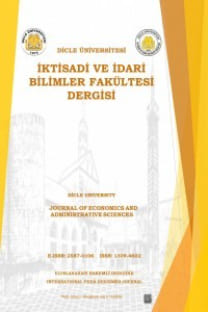HATA TERİMLERİNİN NORMAL DAĞILMAMASI DURUMUNDA SATIN ALMA GÜCÜ PARİTESİ HİPOTEZİNİN SINANMASI: RALS-LM VE RALS-ADF BİRİM KÖK TESTİ
Bu çalışmada, Türk lirası için Satın Alma Gücü Paritesi (PPP) hipotezinin geçerliliği 2002-2018 dönemi için Euro, Dolar, GBP (Sterlin) ve Ruble için araştırılmıştır. Literatürde PPP hipotezinin geçerliliğinin sınanmasında geleneksel birim kök testleri kullanılmaktadır. Ancak geleneksel birim kök testleri, normal dağılıma uyan kalıntıları gerektirir. Bununla birlikte, reel döviz kuru serilerinin birim kök analizlerinde hata terimi genellikle normal dağılmamaktadır. Bu bağlamda, çalışmada hata terimlerinde normallik varsayımını genişleten RALS-LM birim kök testi stratejisine dayanarak PPP hipotezinin geçerliliği sınanmıştır. Elde edilen bulgulara göre, PPP hipotezi ABD Doları ve GBP (Sterlin) için geçerlidir. Bu çalışmadan elde edilen bulgular iki açıdan PPP hipotezi literatürü için önem taşımaktadır. Birincisi, reel döviz kuru serileri geleneksel birim kök test prosedürleri için uygun değildir ve ikincisi, normallik varsayımı gerektirmeyen testler kullanılsa bile reel döviz kuru serilerinde durağanlık araştırılan döneme oldukça duyarlıdır.
TESTING THE ABSOLUTE PURCHASING POWER PARITY HYPOTHESIS UNDER NON-NORMAL ERRORS: RALS-LM AND RALS-ADF UNIT ROOT TESTS
This paper scrutinized the validity of the Purchasing Power Parity (PPP) hypothesis for the Turkish Lira along with the Euro (19), the Dollar, the Ruble and GBP for the period between 2002 and 2018. In the related literature, the conventional unit root test procedures are often used in examining the validity of the PPP hypothesis. However, the conventional unit root procedures require normally distributed residuals. But the real exchange rate series rarely satisfy this condition. Hence, this paper investigates the validity of the purchasing power parity (PPP) relying on the RALS-LM unit root procedure, which stretches the assumption of normality. The RALS-LM (one and two trend shift) test findings revealed that PPP hypothesis holds just for the dollar and the GBP. This paper has two vital results in terms of the current PPP literature. Firstly, conventional unit root test procedures are not appropriate for testing the real exchange rate series and secondly, even though appropriate unit root testing procedures were used the results are still very sensitive to the chosen data range.
___
- Bai, J., and Perron, P. (1998), “Estimating and Testing Linear Models With Multiple Structural Changes”, Econometrica, p.47-78.
- Bai, J., and Perron, P. (2003), “Computation and Analysis of Multiple Structural Change Models”, Journal of Applied Econometrics, 18(1), p.1-22.
- Balassa, B. (1964), “The Purchasing-Power Parity Doctrine: A Reappraisal”, Journal of Political Economy, 72(6), p.584-596.
- Bilgin, C. (2018), “Uluslararası Ticarette Satın Alama Gücü Paritesinin Geçerliliği Sorunu: Türkiye için Zaman Serisi Analizi”, Academic Review of Humanities and Social Sciences, 1(1), s.17-30.
- Cassel, G. (1918), “Abnormal Deviations in International Exchanges”, The Economic Journal, 28(112), p.413-415.
- Central Bank of the Republic Turkey (TCMB) (2019), Statistical Data (EVDS), Exchange Rates. https://www.tcmb.gov.tr/wps/wcm/connect/en/tcmb+en (Access Date: 11.01.2019)
- Coşkun, N. (2020), “Mutlak Satın Alma Gücü Paritesi Hipotezi: Kırılgan Beşli Örneği”, Bulletin of Economic Theory and Analysis, 5(1), s.41-55.
- Dickey, D. A., and Fuller, W. A. (1979), “Distribution of The Estimators For Autoregressive Time Series With a Unit Root”, Journal of the American statistical association, 74(366a), p.427-431.
- Dickey, D. A., and Fuller, W. A. (1981), “Likelihood Ratio Statistics For Autoregressive Time Series with a Unit Root”, Econometrica: Journal of the Econometric Society, p.1057- 1072.
- Erlat, H. (2004), “Unit Roots or Nonlinear Stationarity in Turkish Real Exchange Rates”, Applied Economics Letters, 11, p.645–50.
- Gerber,J., (1999), International Economics, Addison-Wesley Educational Publisher Inc., USA
- Im, K. S., Lee, J., and Tieslau, M. A. (2014), More Powerful Unit Root Tests With Non-Normal Errors, In Festschrift in Honor of Peter Schmidt (pp. 315-342). Springer, New York, NY
- Kalyoncu, H., (2009), “New Evidence of The Validity of Purchasing Power Parity From Turkey”, Applied Economics Letters 16(1), p.63-67.
- Meng, M., Im, K. S., Lee, J., and Tieslau, M. A. (2014), More Powerful LM Unit Root Tests with Non-Normal Errors, In Festschrift in Honor of Peter Schmidt (pp. 343-357). Springer, New York, NY.
- Meng, M., Lee, J., and Payne, J. E. (2015), “The Prebisch-Singer Hypothesis and Relative Commodity Prices: Further Evidence On Breaks and Trend Shifts”, Working Paper, University of Alabama.
- Meng, M., Lee, J., and Payne, J. E. (2017), “RALS-LM Unit Root Test With Trend Breaks and Non-Normal Errors: Application To The Prebisch-Singer Hypothesis”, Studies in Nonlinear Dynamics and Econometrics, 21(1), p.31-45.
- Meng, M., Payne, J. E., and Lee, J. (2013), “Convergence in Per Capita Energy Use Among OECD Countries”, Energy Economics, 36, 536-545.
- OECD (2019), OECD Statistics, https://data.oecd.org/ (Access Date: 11.01.2019).
- Ozdemir, Z. A. (2008), “The Purchasing Power Parity Hypothesis in Turkey: Evidence From Nonlinear STAR Error Correction Models”, Applied Economics Letters, 15(4), p.307- 311.
- Perron, P. (1989), “The Great Crash, the Oil Price Shock, and The Unit Root Hypothesis”, Econometrica: Journal of the Econometric Society, p.1361-1401.
- Sarno, L. (2000), “Real Exchange Rate Behaviour in High Inflation Countries: Empirical Evidence From Turkey, 1980–1997”, Applied Economics Letters, 7, p.285–91.
- Schmidt, P., and Phillips, P. C. (1992), “LM Tests for a Unit Root in The Presence of Deterministic Trends”, Oxford Bulletin of Economics and Statistics, 54(3), p.257-287.
- Şener, S., Yılancı, V. and Canpolat, E. (2015), “Satın alma Gücü Paritesi ve Varyasyonlarının Türkiye için Sınanması”, Uluslararası Yönetim İşletme ve İktisat Dergisi, 11(25), p.53- 63.
- Telatar, E., and Kazdagli, H. (1998), “Re-Examine the Long-Run Purchasing Power Parity Hypothesis for a High Inflation Country: The Case of Turkey 1980–93”, Applied Economics Letters, 5(1), p.51-53.
- Tıraşoğlu and Yıldırım, B. (2014), “Yapısal Kırılmalı Birim Kök Testleri ile OECD Ülkelerinde Satın alma Gücü Paritesi Geçerliliğinin Testi”, Ekonometri ve İstatistik, 20, s.68-87
- ISSN: 1309-4602
- Yayın Aralığı: Yılda 2 Sayı
- Başlangıç: 2011
- Yayıncı: Dicle Üniversitesi
Sayıdaki Diğer Makaleler
Gülfer BÜYÜKTAŞ GAYIR, Zübeyir ÖZÇELİK
Fatih ŞANTAŞ, Gülcan ŞANTAŞ, Bünyamin DEMİRGİL
YARI KAMUSAL MALLAR VE ASİMETRİK BİLGİ ARASINDAKİ İLİŞKİ BAĞLAMINDA SAĞLIK HİZMETLERİ
AN EMPIRICAL INVESTIGATION ON THE SOCIOECONOMIC DETERMINANTS OF DIVORCE RATES IN CEE COUNTRIES
POST-FORDİZM, ESNEKLİK VE EPDK
İŞYERİNDE KÖTÜ MUAMELE, MOTİVASYON VE PERFORMANS İLİŞKİSİ
Süreyya ECE, Serkan TOKGÖZOĞLU, Delil OĞUZ
SPOR İŞLETMECİLİĞİ YÖNETİMİNDE SAYISAL KARAR YÖNTEMLERİ VE UYGULAMALARI
